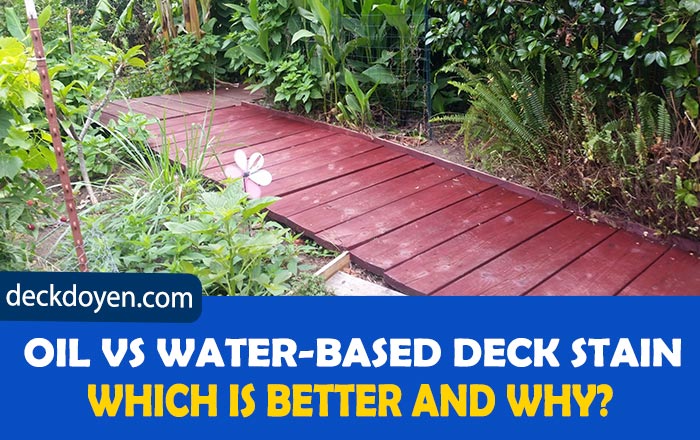Are you planning to paint your deck and confused about staining with an oil-based paint or water-based dye? Well, this is not a challenging choice because both types of stains are best for deck staining. However, both have variable properties. So, you just need to identify which will go best with your deck.
Oil-based paints are preferable for robust weather conditions, high-traffic locations, and wood that lacks inherent rot protection. Mineral spirits make cleanup a breeze. Since cedar, oak, and mahogany are naturally resistant to rotting, water-based stains are preferable. Their cleaning is also simple with soap and water.
I will look at oil-based and water-based stains, their advantages, drawbacks, and which is best for what reasons, to further grasp the variations. Till the end of this article, you must have an in-depth knowledge of how oil and water-based stains differ and how and when to apply them.
So, let’s read on to know when to stain a deck floor with water-based dye and when to use oil-based wood paint.
Also Read: How Often Should You Stain Your Deck? – Ultimate Guide
Which One Is Best? Oil-Based Stain Vs Water-Based Stain:
There are multiple characteristics of oil-based wood paints and water-based deck stains. Where oil-based deck stain is water resistant, water-based colors are not. Hence, both have variable benefits. So, let’s compare the properties of both deck stains to know which one to use.
The Stain Base Or Pigment Solvent Type:
The main distinction between the two stains is that one is dissolvable in the water while the other needs oil. The solvent characteristics cause oil-based stains and water-based deck stains to act differently.
The Drying Time:
Water-based deck stains take very little time to dry out due to water’s property that allows them to dry quickly. In contrast, oil-based paints are heavier than water and take 24 hours to dry. The drying time varies because the solvent of the dye must evaporate fully for 100% drying.
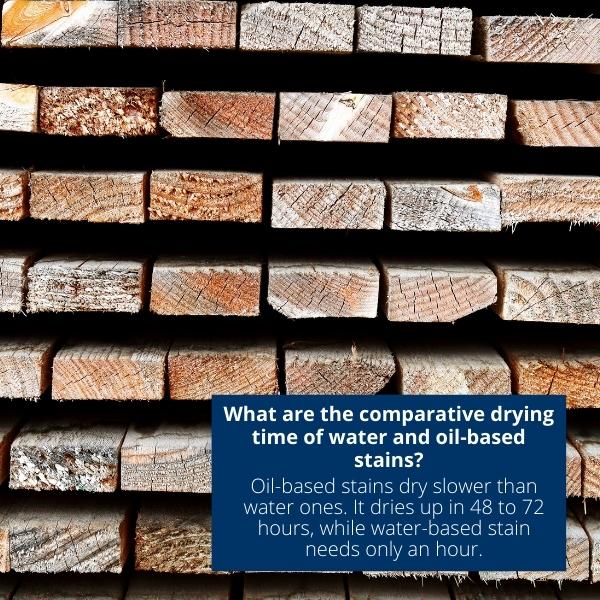
You will also need to wait at least 2 to 3 days before recoating the deck with oil-based dyes. Comparatively, water fully evaporates in 30 to 40 minutes drying the water-based deck stain early.
However, the atmosphere affects the paint’s cure time more than the solvent. Therefore, the two stains’ cure times may differ.
Resistance To Scratching:
Compared to water-based stains, oil-based stains seem to be highly scratch-resistant. It is due to the glossy sheen of oil-based paints. The top coat keeps the deck shielded from scratches and claw marks. On the other hand, water-based dyes are rapidly damaged by dents and scratches because the surface is dry and devoid of a natural sheen.
Also Read: Should You Power Wash A Deck? Problem Solved!
Endurance And Quality:
Water-based stains are weaker and last lesser than oil-based deck stains. It is because oil-based deck stains take longer curing time than water-based pigments, giving the dyes additional time to thicken.

Oil-based stains stay longer, unlike water-based paints, because they are more rigid and can withstand scratches, distortions, and cracking effectively.
Finish Characteristics:
While water-based stains leave a dry, grainy finish, oil-based dyes leave a glossy appearance. Because oil makes up a large portion of the paint, it has a shiny top coat. Conversely, water-based colors frequently produce a more vibrant and fresh finish than oil-based stains. Therefore, it depends on your liking of the coat finish which one you choose.
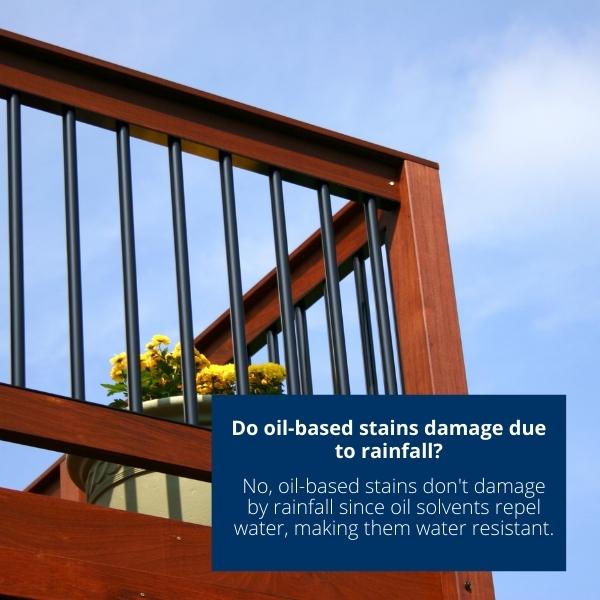
Moisture-Resistance:
Since the solvent of water-based deck stains is none other than water, they do not repel moisture. Hence, It quickly absorbs water, whereas oil-based stains don’t. Oil-based wood paints typically can resist moisture because of the top coat. Additionally, the oil is insoluble in water, that’s why it resists water.
Indoor Vs Outdoor Usability:
Water and oil-based stains are usable for both outside and inside locations. You simply need to select an interior or exterior paint. Water-based stains dry quickly and have a low level of paint ingredients or VOCs (volatile organic chemicals). That’s why water-based dyes are more common for Indoors than outdoor stains.
Paint fumes can quickly dissipate in the open air. Therefore oil-based stains are perfect for outdoors. Furthermore, oil-based deck stains are more durable and water-resistant, allowing the dye to bloom outside.
Maintenance And Cleaning:
Maintenance is essential to keep your stain stay fresh longer. Water-based and oil-based stains are both simple to maintain. However, both require different techniques. Water-based stains can be cleaned with a washcloth, while you may need a moist cloth to wipe stubborn stains. On the other hand, oil-based stains are effortless to maintain because they do not collect dust or grime.
Also Read: How To Protect Your Deck From The Weather?
The Price:
Oils are an expensive raw material. Therefore, oil-soluble products are always pricey. Similarly, oil-based deck stains cost more than water-soluble deck stains. You need more amount of oil-based dyes compared to water-based ones. It also results in additional costs when using oil-soluble paints.
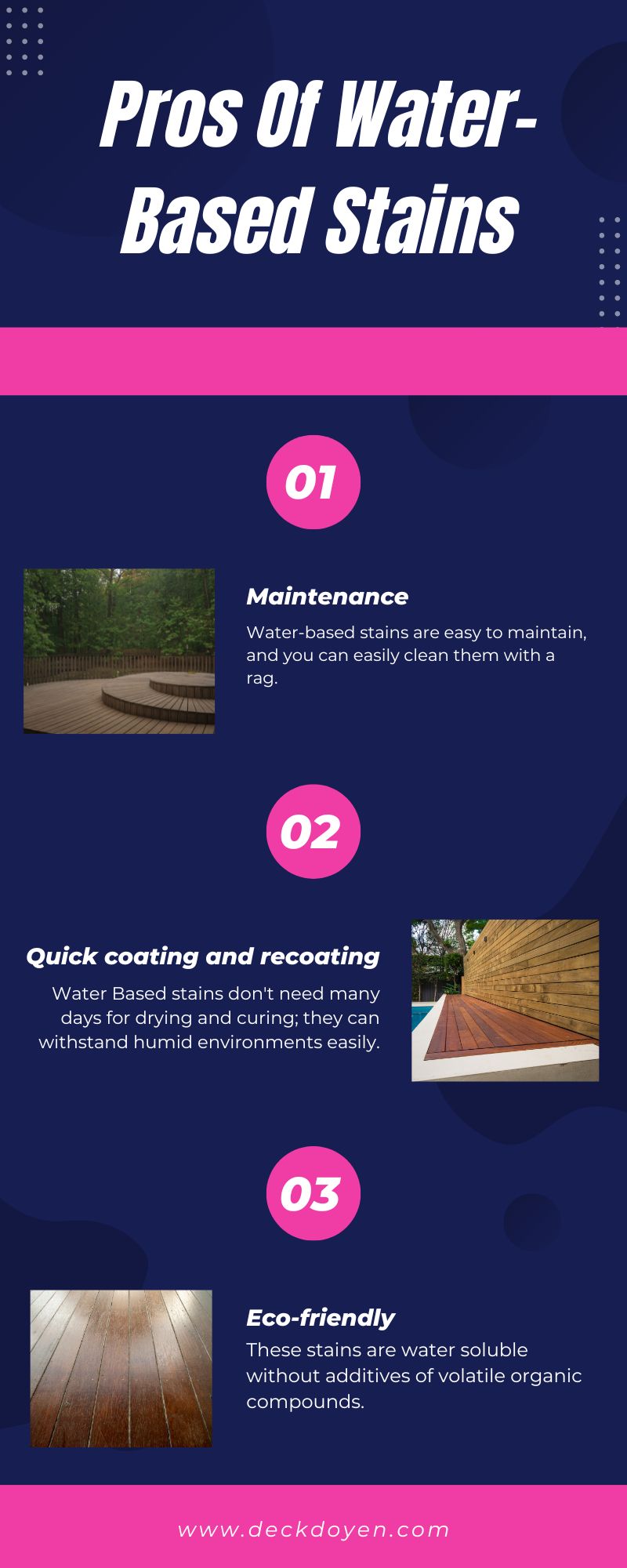
UV Resistant:
Since UV resistance is higher in water-based stains, they do not fade quickly and stay vibrant for more time. Comparatively, oil-based wood paints fade quicker in the sunlight. Comparatively, oil-based wood paints fade quicker in the sunlight and are less UV resistant. So, if your deck faces more sunny days than winter, use water-based dyes for longevity and vice versa.
Application:
You may face more challenges in coating your deck with water-based wood paints than oil-based stains. It is because oil-based dyes infiltrate wood more effectively than water-based wood stains making the painting activity effortless. Conversely, washing is quite challenging upon oil stain spillage. That’s why make sure you don’t spill your oil stain.
What Are The Benefits Of Water-Based Stains Vs Oil-Based Stains:
To decide which paint to apply to your deck, you need to know its comparative benefits. So, let’s understand the advantages of using each stain separately.
Benefits Of Oil-Based Stains:
- Oil-based stains have an even appearance and will not leave lap marks. Because the dry period is significantly longer, blending your brush strokes to create an equal finish is handy and seamless.
- Oil-based stains penetrate the wood so well. Therefore they are effortless to apply.
- Oil-based stains resist peeling better than water-based stains because they soak the wood deeply. When they fail, they gradually fade away instead of peeling away.
- Water-based stains have a glossy top layer. That’s why they are more water resistant.
Benefits Of Water-Based Stains:
- Water-based stains are long-lasting if properly applied.
- They have improved UV resistance and color retention properties.
- Water-based stains do not provide a food source for mold, mildew, or algae. Hence, it limits their growth potential. Nanoparticle-containing zinc stains have considerably greater immunity to mildew growth.
- Cleaning up is straightforward with a water-based dye, and no harsh solvents are necessary.
- It dries rapidly, and you can roam on the deck within 60 to 120 minutes of application.
- These stains are anti-inflammatory with a low smell.
- It has low maintenance requirements. When the gloss of expensive quality water-based stains starts to fade, just wipe the area with soap and water and reapply a maintenance layer without sanding and scrubbing.
Also Read: Best Wood For Decking: Which One To Choose And Why?
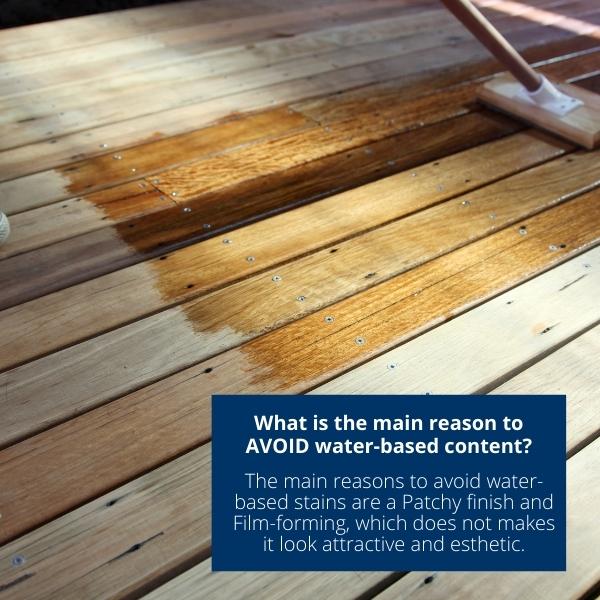
Comparative Drawbacks Of Choosing Oil-Based Stains And Water Based Stains:
Now that I have elaborated on the benefits of both types of deck stains, it’s also vital to help you figure out the potential drawbacks according to their better selection. Here is all that you need to know about the benefits of each sort of deck paint. However, for a better selection, you need to know the potential drawbacks of choosing each stain. So, let’s, move on to the cons of choosing oil-based dyes and water-based colors.
Cons Of Oil-Based Dyes:
- Oil-based deck paints can have a higher level of volatile organic compounds. These compounds are potentially harmful to the environment.
- Water-based stains will outlast oil-based paints.
- They dry slower (up to 48 hours), which might be an issue if you inhabit a humid or damp area.
- The varnishes used in oil-based dyes contain components that serve as a feeding source for mold, mildew, and algae, causing your deck to turn black.
- Oil-based stains are more difficult to remove. You require Mineral spirits for proper cleaning.
- It has lower durability and must be recoated more frequently.
Cons Of Water-Based Dyes:
- Water-based stains require more attention and time to apply – don’t cut corners. The stain will fail if you do not provide enough time.
- Water-based dyes have a more challenging time entering the wood, and they have the potential to peel if over-applied. Make sure you just use as much stain as the wood can absorb.
- Because the stain dries quickly, the paint granules do not get sufficient time to bind fully with the wood.
What Factors Are Important To Consider Between Oil-Based Stain And Water-Based Stains?
There are no correct or incorrect answers in the painting. You should evaluate the pros and cons of each type of stain and your opinions on upkeep and shade. Because no paint type is flawless, it’s a matter of determining which ticks the most boxes.
Also Read: How To Lay Decking On Grass? Step By Step Guide!
Aside from that, it is also vital to consider the type of wood. If the wood in question is more oily, such as cedar or redwood, you should consider using an oil-based stain because they all respond well to oil-based versions. Pressure-treated pine, for example, responds well to water-based deck stains.

If you’re just selling your home and need to stain your deck quickly, or if you don’t mind restaining your deck every year, a cheaper, oil-based stain might be your best alternative. It’s very straightforward. Simply apply the stain, and you’re finished. As long as you don’t mind restaining yearly and aren’t in a damp/humid area or close to trees that can promote mold growth, oil-based paint can be a decent option.
Has your deck previously been stained? If the previous coating was an oil-based deck stain, you must reapply an oil-based paint or use a stain remover to strip the old coating if you wish to shift to a water-based stain. Then it will be suitable for the water-based dye.
The third issue to consider is the amount of outdoor exposure your decking receives. Water-based stains are far more enduring if direct sunlight, wind, or rainfall impact your deck often. They usually are the better decision.
Final Verdict:
Water-based stains take a bit more time and work than oil-based stains, but they last much longer. Oil-based dyes are easier to apply and require less effort, but they do not persist as long as water-based dyes. They also have more fungus, mold, and algal issues and require more upkeep in the future. So, before you start your deck staining task, decide which sort of stain is appropriate for your specific situation. Besides, you must examine your decking requirements. It will help to determine which paint is most suitable for your decks.
Also Read: Can Deck Screws Be Used For Framing?
Though I think that these details should settle the debate over oil Vs., water-based wood stains once and for all, you need to select wisely.
FAQs:
When Should Oil-Based Stains Be Used?
The three main reasons to prefer oil-based stains are as follows:
- They are preferable for outdoor decks.
- To transition from light to dark hues, use oil-based stains.
- You can use oil-based stains to fill and hide gaps and fissures.
Is It Possible To Use Water-Based Stain A Top Oil-Based Stain And Vice Versa?
A water-based stain can be applied over an old oil-based color only when the oil-based stain is completely dry and clean. However, you need to scraper the water-based paints before you recoat your deck with an oil-based one.
How Soon Does A Water-Based Wood Stain Fade?
Water-based stains last longer than you expect. However, most water-based dyes last 24 to 36 months and are more ecologically friendly since they don’t require solvents. However, the refinishing procedure can be time-consuming.

